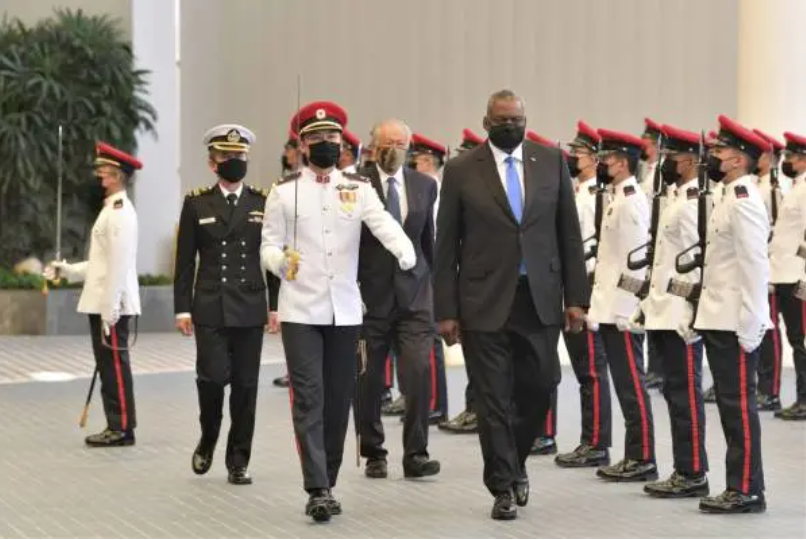Captain (Retired) Tian Shichen is founder and president of the Global Governance Institution and director of the Centre for International Law of Military Operations in Beijing. He is also a China Forum expert
Leon Zhang is an intern at the Global Governance Institution
As US Deputy Secretary of State Wendy Sherman wrapped up her by-the-way visit to China – the subject of intense negotiation, with the two countries unable to agree on the proposed engagement until the very last minute – US Secretary of Defence Lloyd Austin kicked off his visit to America’s allies in Southeast Asia, namely Singapore, Vietnam and the Philippines.
Austin’s high-profile visit to Asia aims to reaffirm the new administration’s commitment as “a reliable partner”. In remarks before the trip, Austin referred to these destinations as America’s “priority theatre of operations” and said the major goal of his visit was to strengthen the “powerful network of allies and partners in the region”.
Further, he said, he would take the opportunity to make clear the US stance on challenging what he called “unhelpful and unfounded” claims by China in the South China Sea.
His key message was echoed in his speech in Singapore.

To boost allies’ confidence in America’s military commitment, Austin showcased America’s military muscles: before flying to Asia he visited Alaska’s Eielson Air Force Base, where he made a speech against the backdrop of three F-35 Lightning II aircraft.
In fact, the US is pushing to boost its military presence in the Indo-Pacific to counter the alleged China threat. A few days ago, Captain Michael Luckett, a submarine commander with experience in the Indo-Pacific, took over command of the Guam Naval Command.
Meanwhile, according to the Centre for a New American Security, a Washington-based think tank, the US appears to be moving towards a strategy of “full spectrum competition” in preparation for a possible great-power conflict.
All of the above is consistent with a single message that corresponds to US President Joe Biden’s declaration that “America is back”. But could the US really be back in the Asia-Pacific as it used to be after World War II? Asking this brings more questions than answers.
“We believe that we’re a stabilising force; no matter where we are, what part of the world, we add value to the stability of the region,” said Austin. But while he was making these beautiful official statements, the drawdown of American and Nato forces in Afghanistan is causing chaos.
Hundreds of thousands of civilian and military lives have been lost in the US-led “war on terror” in Afghanistan, yet the prospects for peace and stability in the country remain dim. After nearly 20 years of war, one might ask how the US has contributed to the stability of that region.
And let’s not forget Vietnam and the Korean peninsula. The Korean war and the Vietnam war were humanitarian catastrophes and the aftermath of both wars is still being felt – not least by the Vietnamese who were made refugees by the hostilities and the Korean families parted by war.
It would be interesting to hear Austin extol America’s role as a “stabilising force” in Vietnam when he visits.
In Singapore, Austin pledged that the US would build partnerships that would allow countries to make their own decisions. This is doubtful.
There is a long-standing consensus in Asia and the Pacific that the region depended on China for economic growth and the US for security. But as China’s economy grew to be the world’s second-largest, its increasing global influence inevitably challenges the alliance system that forms the basis for America’s security commitment to its Asian allies.
China’s huge market and abundant economic opportunities are a big draw for other Asian countries. Smaller Asian nations that benefited from the prosperity brought by China’s boom now find themselves more dependent on China than ever before.
This security-versus-development dilemma is further complicated by big-power competition as the hawkish US policy that was imposed on China by the Trump administration is inherited by the Biden administration.
When Austin vows to strengthen America’s network of allies and partners, no one doubts that he is asking these allies and partners to choose sides, the same as the US has done in Europe. Forced to choose, how could these Asian countries exercise their sovereign right of making their own decisions, as Austin promised?

People walk past shops in Beijing on May 12. China’s huge market and abundant economic opportunities are a big draw for other Asian countries. Photo: AP
Last but not least, no one knows how long this policy of Biden’s administration may last. In 2012, then-US president Barack Obama announced America’s “pivot to Asia”, a doctrine aimed at rebuilding America’s leadership role. Obama’s efforts, however, were soon undermined by his successor, Donald Trump, who preferred unilateral decisions and abandoned many of America’s partnerships with Asia.
The change of government under the US democratic system brings huge uncertainty not only to Asian countries but also to the whole international community.
At a time when fighting the Covid-19 pandemic and restoring the economy are top priorities for the world, international cooperation is more necessary than ever. Yet the US has used every lever it has to push big-power competition.
When its Asian network of allies and partners is also being used to push big-power competition, the dilemma of having to choose a side will be thrust upon nearly every state, like it or not. How much can the US be trusted to deliver on its boast that it plays a stabilising role in the region? That’s the question.
